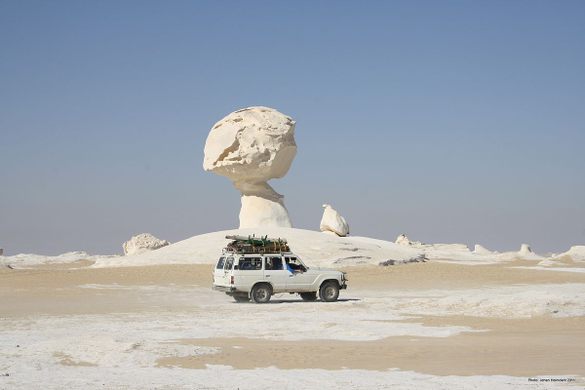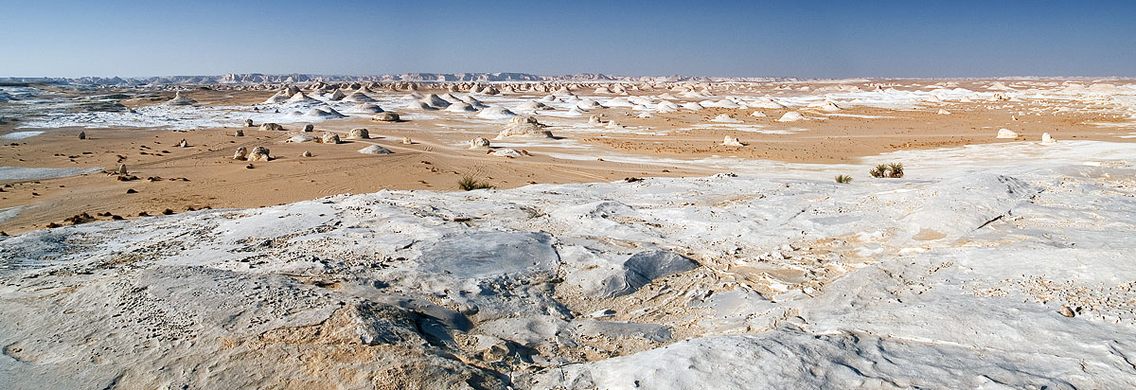Bahariya Oasis
Bahariya Oasis
Do and See
The White Desert
Just leaving behind the Bahariya Oasis, and only less than 40 KM before Farafra is
the stunning White Desert, a must see desert as its uniqueness values such visit.
Originally, the White Desert in the remote past (some millions of years ago) was the
sea bed of the great sea covering almost all North Africa, the sedimentary layers of
rock formed by marine fauna when the sea has been dried up. The nowadays Chalk-
white landscape is a house of different strange shapes, in fact the formations are given
descriptive names after being sculpted by winds of time (but in reality the shapes
constantly changed over time) The quantity of unearthly and beautiful rock
formations shaped in the form of giant mushrooms, rabbits, ice cream cones, or
pebbles, to name but a few of what's in there which is hard to be found in any desert
in the world.
The White Desert is a really nature wonder, that few years ago, it came to be declared
a protected area (or a National Park).
Temple of Ain IL- Meftella
Few kilometers from Bahariya (on the main road between it and Siwa) is a unique site
dated back to the 26 th Pharaonic dynasty (from the time of king Amasis II / who is
now after uncovering the name of another Amasis before Amasis the 1 st ,came to be
known as Amasis III), the ruins indicate a temple of four chapels, the largest bears
scenes of the king making offerings to various gods in Ancient Egypt.
The two tombs of Bennatiu & Djed Ankh Amun iw-ef
The close-by two tombs, date back to the 26 th dynasty (6 th century BC), which was the
golden era of the Oasis' history, both together with another two were uncovered by the
famous Egyptian Egyptologist Late Mr. Ahmed Fakhry in 1938. The two tombs are
considered the most beautiful in the area due to their rich decorations and vivid colors
of the wall paintings. Both men (the owners) were high officials in the area (perhaps
governors) as well as members of the wealthiest family then, they were father (Djed-
Amun) and son (Bennantiu).
Of "Djed-Amun's tomb" we admire such funerary and religious scenes, including one
representing the four sons of god "Horus". While in the tomb' chamber we do admire
the most famous scene of the hall of judgment (where the underworld god Osiris is
the judge) (known as the final judgment) in such judgment the heart of the deceased is
to be weighed against a feather representing "truth and justice" once proved heaver
was declared full of sins and no admission to the after-life, but if the opposite was
admitted to the kingdom of Osiris and enjoy eternal life in the (Iyaro-Paradise). While
the next tomb of the son, bear less decoration but still in good condition, and it seems
to be re-used during the Roman Period, has a basilica-shaped hall with two columns
dividing the place into-two equal parts, and the wall scenes are similar of the father's
tomb, mostly of religious and offering scenes.
The Museum of the Golden Mummies
More than a decade, the story tells, that- an official working in the then, S.C.A
(Supreme Council of Antiquities/Now a combined Ministry of Tourism and
Antiquities), his donkey fell in a deep pit, announcing after systematic Work of
digging a great Discovery in the Valley, which is now called the (Valley of the
Golden Mummies). Excavations there revealed a great number of Mummies (dating
back to the Roman Period- and mostly are gilded), of a total a 105 mummies found,
but according to the then (Supervisor of SCA Zahi Hawas) it is expected to uncover
more than 10.000 of them in the Area- lastly need to know that the man behind such
fabulous discovery is Dr. Mansour Borik (one of the Best Egyptologist in the Field of
Excavation as he was the man behind many others like the city of The Pyramid'
Workers at Giza with The American Egyptologist Mark Lhener).
The Black Desert
The name sounds the opposite of the white desert, and it is, as the Black desert which
is some 50 KM from Bahariya is the visible evidence of volcanic activities in the Area
in the remote past, billions of such black rocks (called dolerite) covering the slightly
medium height mounts / or hills at the back end of the desert, showing the volcanic
eruptions through the geological ages. Don't miss the chance to climb high up one of
the hills but be cautious when climb down as the small rocks roll under your feet.
Gebel IL-Ingelese (The English Mount)
The flat-topped Mount took its present name of being a World War II Lookout Spot.
(as the story tells- it was from here that the British Officer Captain Williams
monitored and observed the Infiltration of the Libyan "Senussi" tribesmen. Get high
up before sunset (in less than 10 minutes' walk) and enjoy a wonderful panoramic
view which rolls out across the Oasis and its vast desert.
Temple of Alexander the Great
To the southwest of the village Bawiti" is one of few places in Egypt bearing the
name of the Young-Macedonian Conqueror who founded the largest ever empire,
extending more than 40.000 SQ,M, from historical records we know that Alexander
on his way to Siwa sailed down the Nile Northwards and from the point became now
"Alexandria" he moved southwards to avoid the seasonal sand-storms which one day
covered and wiped-out a Persian Army- but on his way back from Siwa he took the
route of Siwa-Bahariya as no sand-storms occurred then, therefore, perhaps he
ordered this small (looks unimpressive- regarding to Alexander name) temple to be
built, it worth a visit its builder.
Ain Gommaa Spring
Some 50 KM To the south of the Oasis, on the way to the small city of IL-Hayz is one
of the most cool, Crystal-Clear water springs flowing into a small-size pool confined
by nothing but by vast desert, enjou a drink in the site-typical café and shop of the
region products at the highly recommended spring in the Oasis.
Biir Mattar (Well of Mattar)
In case that you do have only one day trip in Bahariya and need to experience its
Mineral-Water Springs, so this well is a highly recommended as it's only seven KM
away, where you enjoy in a hot day-time a cold spring pouring into a viaduct and then
down into a built-up concrete pool.
N.B
As of the entire Regions' Springs, the mineral content (especially Iron) is so high, to
the extent to stain the clothes. So be cautious.
The Crystal Mountain
On the way to the White Desert and Farafra, don't miss a stop at the Crystal
Mountain, a calcite pure Crystals in the form of a little mount/or hill, worth a stop but
without handling any part of, as being a protected place.





